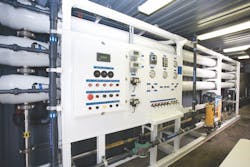About the author:
Julie Nemeth-Harn, P.E., is vice president of Harn R/O Systems Inc. Nemeth-Harn can be reached at [email protected] or 941.488.9671.
Pilot studies have been an important part of membrane water treatment since its inception more than 30 years ago. They are small-scale tests that are useful in determining the applicability of membrane treatment to an individual water source. Valuable data can be obtained that may minimize expensive mistakes in the full-size treatment plant.
The definition of a pilot study can vary widely, from a small bench-scale test operated over a period of a few days to a large 0.5-million-gal-per-day (mgd) to 1-mgd demonstration-scale study that can operate for several years. The challenge is to formulate the appropriate study for the particular water treatment need.
Criteria
The following criteria should be considered when evaluating the recommended scale and duration of a pilot study:
• Size and complexity of the proposed full-size plant;
• Prevalence of existing membrane treatment on the target water source;
• Unusual feedwater characteristics;
• Unusual finished water quality requirements;
• Potential for variation in feedwater quality (particularly surface waters);
• Permitting requirements (some states require pilot studies); and
• Desire to optimize design for low operation and maintenance costs and long membrane life.
Ongoing Operations
In addition to piloting for new plant design, pilot studies also are useful in ongoing membrane plants to test possible variations in operation. For example, there has been a trend in recent years to remove acid pretreatment for scale control from brackish reverse osmosis (RO) plants as a result of dramatic increases in acid prices and an improvement in polymer scale inhibitor effectiveness.
This is most safely accomplished by performing a three-month pilot-scale test prior to reducing the acid dosage in the full-size plant. Many large membrane treatment plants purchase a pilot unit as part of the plant construction contract so that new membranes, cleaning chemicals or other changes in operation can be tested on site.
Size & Duration
Determining the size and duration of a pilot study must take into account the type of design data needed and the owner’s schedule and budget. Bench-scale or single-element tests are useful for obtaining rudimentary data regarding the suitability of a water source for membrane treatment. To obtain meaningful data on design parameters (e.g., optimum membrane choice, design flux and projected cleaning frequency), a full-scale pilot study should be performed.
A full-scale pilot system is the smallest production system that can be built that accurately duplicates the design of a full-size production system. For a spiral-wound RO system, the benefit of the full-scale pilot system is that it incorporates full-length, six- or seven-element pressure vessels that give the pilot system the ability to duplicate full-scale design conditions without requiring concentrate recycle to increase recovery. Recycling the concentrate to achieve higher recoveries produces an unnatural feedwater, making it impossible to determine overall permeate quality, blend ratios, chemical use, power consumption, fouling rates, cleaning frequencies and projected membrane life. The pilot system should incorporate all the major design elements the full-size plant would require, including pretreatment, chemical feeds and instrumentation and control.
Pilot study duration is determined by the variability of the water source and the number of parameters to be varied and tested. For surface water treatment, the test ideally should operate for a year to capture all seasonal variations. A groundwater source typically can be thoroughly tested in a three-month period. The basic cost for a pilot study utilizing a rental unit can range from about $75,000 to $150,000 for a three-month RO pilot to $500,000 or more for a yearlong complex pilot study, not including engineering administration. The investment will pay off when the design of the production system enables operation at the highest possible efficiency and the lowest possible life-cycle cost.
Download: Here
